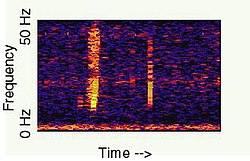Bloop
50°00′00″S 100°00′00″W / 50.000000°S 100.000000°W

The Bloop is the name given to an ultra-low frequency and extremely powerful underwater sound detected by the U.S. National Oceanic and Atmospheric Administration several times during the summer of 1997. The source of the sound remains unknown.
Analysis
The sound, traced to somewhere around 50° S 100° W (South American southwest coast), was detected repeatedly by the Equatorial Pacific Ocean autonomous hydrophone array, which uses U.S. Navy equipment originally designed to detect Soviet submarines. According to the NOAA description, it "rises rapidly in frequency over about one minute and was of sufficient amplitude to be heard on multiple sensors, at a range of over 5,000 km." An oft repeated claim is that it matches the audio profile of a living creature [1][2][3][4] though some people say this view is primarily held by cryptozoologists and is not popular among mainstream scientists. If the sound did come from an animal, it would reportedly have to be several times the size of the largest known animal on Earth, the Blue Whale.[5] There are several recorded cases of unknown sounds like the Bloop being picked up by NOAA and thus the Bloop is not a unique phenomenon.[6]
See also
References
- ^ "The Call Of The Bloop".
- ^ "the Bloop audio that baffles researchers".
- ^ "The bloop - An Unexplained Phenomenon [Actual Sound]".
- ^ "The Hip Forums".
- ^ "Tuning in to a deep sea monster". CNN.com. June 13, 2002.
- ^ http://www.pmel.noaa.gov/vents/acoustics/specs_all.html.
{{cite news}}: Missing or empty|title=(help)
- John von Radowitz, (June 13, 2002). "Beware the Bloop". The Age.
{{cite news}}: CS1 maint: extra punctuation (link) - Richard Stenger (September 7, 2001). "Scientists tune in to sounds of the sea". CNN.

